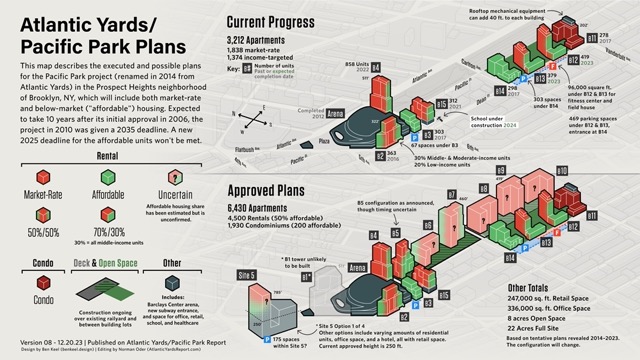In a New York Times package regarding places to build more housing, curious treatment of Atlantic Yards, as some sites ignored.
There's something curious in How to Make Room for One Million New Yorkers, a New York Times guest essay yesterday (so far, online only) by Vishaan Chakrabarti, founder of NYC-based Practice for Architecture and Urbanism, and the NYC Department of City Planning's former director of planning for Manhattan.
To accommodate those needing housing, Chakrabarti dismisses arguments for rent regulation and banning pieds-à-terre and converting vacant office towers as inadequate solutions
He contends the city could in fact build 500,000 housing units—Mayor Eric Adams' “moonshot goal”--and at the scale of their neighbors.
His team focused on areas within a half-mile of train stations and ferry terminals and excluded zones at risk of flooding--so, nope, Red Hook--and identified more than 1,700 acres of underutilized land, including "vacant lots, single-story retail buildings, parking lots and office buildings that could be converted to apartments."
 |
| Screenshot from New York Times |
Other factors
That doesn't necessarily make construction cost-effective, which is another issue.
And he ignores the benefit of new transit, such as a new subway line on Utica Avenue (long proposed), new Bus Rapid Transit, the future Interborough Express between Brooklyn and Queens, and thinking regionally, such as coupling northern New Jersey better to New York,
Around Atlantic Yards
As noted in the large screenshot above, Atlantic Avenue in western Brooklyn is highlighted for potential high-rises. Drilling down is murky, but there aren't that many sites left.
One of the most prominent such sites is, as shown in my annotated screenshot at right, Site 5 of Atlantic Yards/Pacific Park, long home to the big-box stores P.C. Richard and the now-closed Modell's.
That's already approved for a substantial 250-foot, 440,000 square foot tower, but the project developer has long floated a plan to transfer the bulk of the unbuilt B1, the tower planned to loom over the arena, across Flatbush Avenue.
That could create a two-tower project with more than 1.1 million square feet and, perhaps, larger buildings over the Vanderbilt Yard.
Note that, while it has in fact been approved, Chakrabarti ignores the B1 tower. He also ignores the potential for three towers over the Atlantic Center mall, though the zoning permits such construction.
And, oddly enough, the black rectangle within Block 1120 (pink arrow) contains only part of the railyard block between Sixth and Carlton avenues.
I suspect that's an artifact of his methodology, which found underutilized lots using the Department of City Planning’s PLUTO dataset, which likely hasn't fully accommodated the Atlantic Yards/Pacific Park plan.
In other words, there are pieces of terra firma, previously home to what were called the "bump buildings," jutting south of Atlantic Avenue into the Vanderbilt Yard. But the entire block has been approved for towers, contingent on construction of a platform.
Similarly, his treatment of Bloack 1121, the eastern block of the railyard, leaves only a small vertical strip for construction. See my green arrow.

That's visible in the photo at right at the very eastern end of the railyard: parcels once home to auto use.
Again, the entire block has been approved for towers, contingent on construction of a platform.
Also noted, as I've annotated the screenshot, the numerous parcels in Prospect Heights and Crown Heights that are part of the pending Atlantic Avenue Mixed-Use Plan, or AAMUP.
A companion piece
Also see I Want a City, Not a Museum, a companion essay by editorial board member Binyamin Appelbaum, who blames the shortage of housing on "layers of laws to protect existing buildings and to impede the construction of new ones."
Building on Chakrabarti's essay, he argues that even more new homes could be built at existing scale if existing housing were torn down.
That involves, he suggests, reversing historic districts (an idea that of course provoked pushback in the comments) and zoning that is reserved for single-family homes, as well as zoning that restricts new buildings below the existing scale. As noted in the comments, he also ignores the regional solution.


Comments
Post a Comment